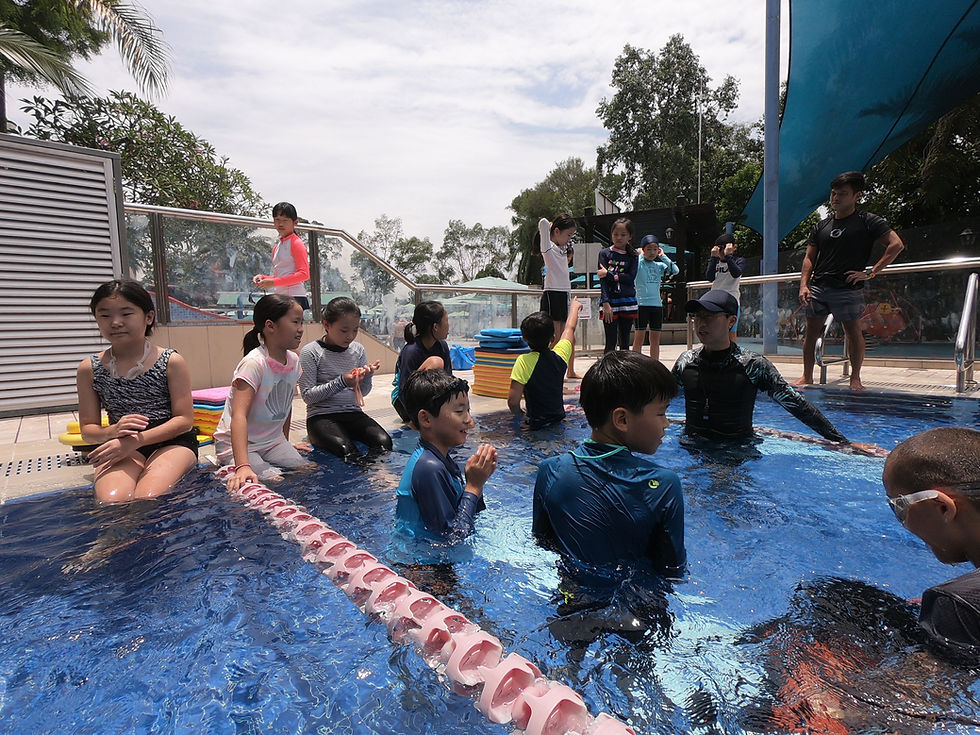Tips for Staying Calm While Teaching Toddlers to Swim
- SG Sink Or Swim

- Jun 19
- 3 min read

Teaching toddlers to swim can be one of the most rewarding experiences — and one of the most challenging. Between splashing, clinginess, short attention spans, and the occasional meltdown, it's easy for even the most patient instructors or parents to feel overwhelmed.
But staying calm is crucial. Toddlers feed off your energy, and your ability to remain composed sets the tone for confidence, safety, and progress in the water.
Whether you're a swim instructor, a caregiver, or a parent, these practical tips will help you stay calm and positive while teaching toddlers how to swim.
🧠 1. Adjust Your Expectations
Toddlers don’t learn linearly — one day they’re floating confidently, the next day they won’t let go of your neck.
✅ Expect progress in small steps, not perfect strokes. If your goal is simply water comfort and fun, you’re already succeeding.
🕒 2. Keep Lessons Short and Sweet
Overly long sessions can lead to fatigue, frustration, and tears (for both of you). A good rule of thumb:
20–30 minutes max for toddlers
End sessions on a positive note, even if it's a small win like blowing bubbles or kicking independently
✅ A short, happy lesson beats a long, stressful one every time.
🗣️ 3. Use Simple, Reassuring Language
Overcomplicating instructions can lead to confusion and resistance. Instead:
Use clear, positive cues: “Kick your legs like a frog!” or “Let’s float like a starfish!”
Avoid negative phrasing like “Don’t be scared” — say, “You’re safe. I’ve got you.”
✅ Clarity builds trust. Trust builds confidence.
🧘 4. Practice Calm Breathing (Yes, You Too)
When a toddler screams, clings, or panics, your stress response kicks in. Breathe deeply and slowly before responding.
Try:
Inhale for 4 counts, exhale for 6
Smile (even if forced) — it helps relax your facial muscles and tone
✅ Your calm breath = their emotional anchor.
🧸 5. Use Toys and Games to Redirect
When frustration builds, shift focus to something fun:
Floating toys
Watering cans
Simple games like “Red Light, Green Light” or “Ring Retrieval”
✅ Fun is the fastest way back to learning.
🤝 6. Let Them Set the Pace (Within Limits)
Some toddlers need more time to feel secure. Forcing them underwater or away from the wall too soon can lead to setbacks.
Offer choices: “Do you want to blow bubbles or kick first?”
Allow them to hold your hand or a toy as a bridge to independence
✅ Empowerment builds courage — on their terms.
💬 7. Talk Through Your Own Calmness
Narrate what you’re doing in a soothing tone:
“I’m going to hold you like this. Now we’re going to float — I’ve got you. We’re safe.”
Hearing your calm, confident voice reassures them more than you realize.
🧩 8. Step Away If You Need To
If you’re reaching your limit:
Pass the child to another instructor or parent (if possible)
Take 30 seconds to reset your breath and energy
✅ You can’t model calm if your cup is empty.
📈 9. Celebrate Tiny Wins
Cheering on small successes builds momentum — for both you and the child. Say:
“You kicked all by yourself — awesome job!”
“I’m so proud of how brave you were!”
✅ Praise encourages repeat behavior and reinforces calm moments.
🏁 Final Thoughts
Teaching toddlers to swim isn’t just about floating and strokes — it’s about connection, trust, and emotional regulation. When you stay calm, you create a safe space where learning can thrive. Even if today’s lesson only includes laughs and water play, you’re laying the foundation for a confident swimmer tomorrow.
So take a breath, smile, and remember — progress happens one splash at a time.





Comments